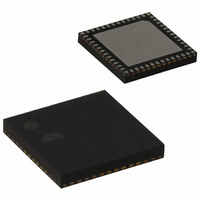EM357-RTR Ember, EM357-RTR Datasheet - Page 60

EM357-RTR
Manufacturer Part Number
EM357-RTR
Description
IC RF TXRX ZIGBEE 192KB 48QFN
Manufacturer
Ember
Specifications of EM357-RTR
Frequency
2.4GHz
Data Rate - Maximum
250kbps
Modulation Or Protocol
802.15.4 Zigbee
Applications
General Purpose
Power - Output
5dBm
Sensitivity
-100dBm
Voltage - Supply
2.1 V ~ 3.6 V
Current - Receiving
26mA
Current - Transmitting
31mA
Data Interface
PCB, Surface Mount
Memory Size
192kB Flash, 12kB RAM
Antenna Connector
PCB, Surface Mount
Operating Temperature
-40°C ~ 85°C
Package / Case
48-QFN
Lead Free Status / RoHS Status
Lead free / RoHS Compliant
Other names
636-1011-2
Available stocks
Company
Part Number
Manufacturer
Quantity
Price
Company:
Part Number:
EM357-RTR
Manufacturer:
SILICON
Quantity:
3 000
Part Number:
EM357-RTR
Manufacturer:
SILICON
Quantity:
20 000
- Current page: 60 of 245
- Download datasheet (12Mb)
7.7
7.8
Wake Monitoring
External Interrupts
The GPIO_PxWAKE registers specify which GPIOs are monitored to wake the processor. If a GPIO’s wake enable
bit is set in GPIO_PxWAKE, then a change in the logic value of that GPIO causes the EM35x to wake from deep
sleep. The logic values of all GPIOs are captured by hardware upon entering sleep. If any GPIO’s logic value
changes while in sleep and that GPIO’s GPIO_PxWAKE bit is set, then the EM35x wakes from deep sleep.
(There is no mechanism for selecting a specific rising-edge, falling-edge, or level on a GPIO: any change in
logic value triggers a wake event.) Hardware records the fact that GPIO activity caused a wake event, but not
which specific GPIO was responsible. Instead, Ember’s software reads the state of the GPIOs on waking to
determine this.
The register GPIO_WAKEFILT contains bits to enable digital filtering of the external wakeup event sources: the
GPIO pins, SC1 activity, SC2 activity, and IRQD. The digital filter operates by taking samples based on the
(nominal) 10 kHz RC oscillator. If three samples in a row all have the same logic value, and this sampled logic
value is different from the logic value seen upon entering sleep, the filter outputs a wakeup event.
In order to use GPIO pins to wake the EM35x from deep sleep, the GPIO_WAKE bit in the WAKE_SEL register
must be set. Waking up from GPIO activity does not work with pins configured for analog mode since the
digital logic input is always set to 1 when in analog mode. Refer to Chapter 6, System Modules, for information
on the EM35x’s power management and sleep modes.
The EM35x can use up to four external interrupt sources (IRQA, IRQB, IRQC, and IRQD), each with its own top-
level NVIC interrupt vector. Since these external interrupt sources connect to the standard GPIO input path,
an external interrupt pin may simultaneously be used by a peripheral device or even configured as an output.
Analog mode is the only GPIO configuration that is not compatible with using a pin as an external interrupt.
External interrupts have individual triggering and filtering options selected using the registers GPIO_INTCFGA,
GPIO_INTCFGB, GPIO_INTCFGC, and GPIO_INTCFGD. The bit field GPIO_INTMOD of the GPIO_INTCFGx register
enables IRQx’s second-level interrupt and selects the triggering mode: 0 is disabled; 1 for rising edge; 2 for
falling edge; 3 for both edges; 4 for active high level; 5 for active low level. The minimum width needed to
latch an unfiltered external interrupt in both level- and edge-triggered mode is 80 ns. With the digital filter
enabled (the GPIO_INTFILT bit in the GPIO_INTCFGx register is set), the minimum width needed is 450 ns.
The register INT_GPIOFLAG is the second-level interrupt flag register that indicates pending external
interrupts. Writing 1 to a bit in the INT_GPIOFLAG register clears the flag while writing 0 has no effect. If the
interrupt is level-triggered, the flag bit is set again immediately after being cleared if its input is still in the
active state.
Two of the four external interrupts, IRQA and IRQB, have fixed pin assignments. The other two external
interrupts, IRQC and IRQD, can use any GPIO pin. The GPIO_IRQCSEL and GPIO_IRQDSEL registers specify the
GPIO pins assigned to IRQC and IRQD, respectively. Table 7-4 shows how the GPIO_IRQCSEL and GPIO_IRQDSEL
register values select the GPIO pin used for the external interrupt.
Final
7-7
EM351 / EM357
120-035X-000G
Related parts for EM357-RTR
Image
Part Number
Description
Manufacturer
Datasheet
Request
R

Part Number:
Description:
MODULE EM357 PA/LNA W/ANT TG
Manufacturer:
Ember
Datasheet:

Part Number:
Description:
MODULE EM357 NO PA/LNA W/ANT TG
Manufacturer:
Ember
Datasheet:

Part Number:
Description:
MODULE EM357 NO PA/LNA W/RF CONN
Manufacturer:
Ember
Datasheet:

Part Number:
Description:
MODULE EM357 PA/LNA W/RF CONN
Manufacturer:
Ember
Datasheet:

Part Number:
Description:
IC RF TXRX ZIGBEE 192KB 48QFN
Manufacturer:
Ember
Datasheet:

Part Number:
Description:
KIT DEV EMBER ZIGBEE W/PCWH
Manufacturer:
Custom Computer Services Inc (CCS)

Part Number:
Description:
PROGRAMMER USB FLASH EM250/260
Manufacturer:
Ember
Datasheet:

Part Number:
Description:
IC ZIGBEE SYSTEM-ON-CHIP 40-QFN
Manufacturer:
Ember
Datasheet:

Part Number:
Description:
IC ZIGBEE SYSTEM-ON-CHIP 48-QFN
Manufacturer:
Ember
Datasheet:

Part Number:
Description:
IC RF TXRX ZIGBEE 128KB 48QFN
Manufacturer:
Ember
Datasheet:

Part Number:
Description:
INSIGHT ADAPTER FOR EM2XX
Manufacturer:
Ember
Datasheet:

Part Number:
Description:
PROGRAMMER USB FLASH EM250/260
Manufacturer:
Ember
Datasheet:

Part Number:
Description:
IC ZIGBEE SYSTEM-ON-CHIP 40-QFN
Manufacturer:
Ember
Datasheet:

Part Number:
Description:
IC ZIGBEE SYSTEM-ON-CHIP 48-QFN
Manufacturer:
Ember
Datasheet:

Part Number:
Description:
IC RF TXRX ZIGBEE 128KB 48QFN
Manufacturer:
Ember
Datasheet:











